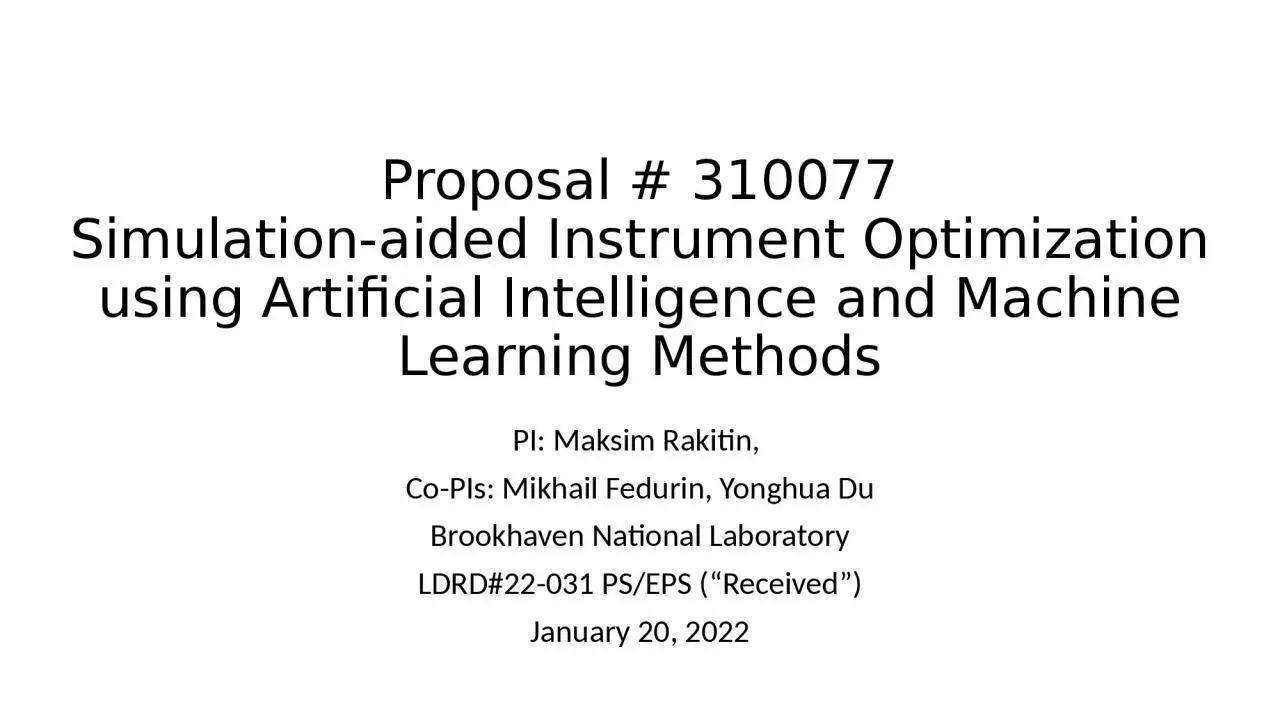

PI Maksim Rakitin CoPIs Mikhail Fedurin Yonghua Du Brookhaven National Laboratory LDRD22031 PSEPS Received January 20 2022 Experiment Goals at ATF Collect ebeam tunning data PS setread BPM read ID: 1031388
Download Presentation The PPT/PDF document "Proposal # 310077 Simulation‐aided Ins..." is the property of its rightful owner. Permission is granted to download and print the materials on this web site for personal, non-commercial use only, and to display it on your personal computer provided you do not modify the materials and that you retain all copyright notices contained in the materials. By downloading content from our website, you accept the terms of this agreement.
1. Proposal # 310077Simulation‐aided Instrument Optimization using Artificial Intelligence and Machine Learning MethodsPI: Maksim Rakitin, Co-PIs: Mikhail Fedurin, Yonghua DuBrookhaven National LaboratoryLDRD#22-031 PS/EPS (“Received”)January 20, 2022
2. Experiment Goals at ATF:Collect e-beam tunning data (PS set/read, BPM read )Process collected data Create AI based e-beam tuning optimization proceduresApply beam optimization on e-beam to match real beam to requested beam parametersIntegrate beam optimization to ATF control system
3. Experiment overview: Bluesky3Bluesky https://blueskyproject.io/bluesky: data collection frameworkOphyd https://blueskyproject.io/ophyd: hardware abstraction libraryDatabroker https://blueskyproject.io/databroker: user-friendly interface for retrieving stored data and metadata from multiple sourcesContributors:NSLS-IIAPSLCLS-IIALS…
4. Sirepo: an open-source cloud-based software interface for X-ray source and optics simulations(https://journals.iucr.org/s/issues/2018/06/00/il5006)Experiment overview: Sirepo4
5. Maksim S. Rakitin, Abigail Giles, Kaleb Swartz, Joshua Lynch, Paul Moeller, Robert Nagler, Daniel B. Allan, Thomas A. Caswell, Lutz Wiegart, Oleg Chubar, and Yonghua Du "Introduction of the Sirepo-Bluesky interface and its application to the optimization problems", Proc. SPIE 11493, Advances in Computational Methods for X-Ray Optics V, 1149311 (21 August 2020) https://doi.org/10.1117/12.2569000Experiment overview: Sirepo-Bluesky library5https://github.com/NSLS-II/sirepo-bluesky
6. Optimization: Genetic Algorithm6https://github.com/NSLS-II-TES/profile_sirepohttps://github.com/NSLS-II/bloptools
7. 7
8. ParameterUnitsTypical ValuesCommentsRequested ValuesBeam EnergyMeV50-65Full range is ~15-75 MeV with highest beam quality at nominal values55Bunch ChargenC0.1-2.0Bunch length & emittance vary with charge0.5CompressionfsDown to 100 fs (up to 1 kA peak current)A magnetic bunch compressor available to compress bunch down to ~100 fs. Beam quality is variable depending on charge and amount of compression required. NOTE: Further compression options are being developed to provide bunch lengths down to the ~10 fs level300Transverse size at IP (s)mm30 – 100 (dependent on IP position)It is possible to achieve transverse sizes below 10 um with special permanent magnet optics.100Normalized Emittancemm1 (at 0.3 nC)Variable with bunch charge1.5Rep. Rate (Hz)Hz1.53 Hz also available if needed1.5Trains mode---Single bunchMulti-bunch mode available. Trains of 24 or 48 ns spaced bunches.Single bunchElectron Beam Requirements
9. Special Equipment Requirements and HazardsElectron BeamNo specific requirementsLarge installation (chamber, insertion device, etc.): No large installationCryogens: No needsIntroducing new magnetic elements: NoneIntroducing new materials into the beam path: NoneAny other foreseeable beam line modifications: None
10. Experimental Time RequestCapabilitySetup HoursRunning HoursElectron Beam Only040Laser* Only (in Laser Areas)00Laser* + Electron Beam00CY2022 Time RequestCapabilitySetup HoursRunning HoursElectron Beam Only2080Laser* Only (in Laser Areas)00Laser* + Electron Beam00* Laser = Near-IR or LWIR (CO2) LaserTime Estimate for Full 3-year Experiment (including CY2022)